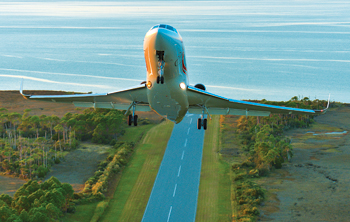INDIAN ARMED FORCES CHIEFS ON
OUR RELENTLESS AND FOCUSED PUBLISHING EFFORTS

SP Guide Publications puts forth a well compiled articulation of issues, pursuits and accomplishments of the Indian Army, over the years

I am confident that SP Guide Publications would continue to inform, inspire and influence.

My compliments to SP Guide Publications for informative and credible reportage on contemporary aerospace issues over the past six decades.
Navigating the Minefield of Acquiring a Bizjet
“This is one of the most traumatic experiences that I have undergone, and I have sworn that I will never make this mistake again.”

Nothing is more traumatic for a potential aircraft operator than going through the process of regulatory nightmare of first acquiring and then getting clearances to operate an aircraft in India. The process can take anything from 12-18 months, from the time you decide to buy an aircraft or helicopter, till the time you actually start flying one. This is not for the weak hearted. In fact, the process probably would make a good case study in one of the IIMs or the Harvard Business School, to bring out why the mission of ‘Ease of Doing Business’ in India, especially in the aviation industry, will never succeed, unless a thorough review of the entire process is carried out and streamlined.


So, this is how it goes presently. You are a potential aircraft/helicopter buyer for the first time, as you have realised that your business will grow manifold in case you have the flexibility and mobility to travel as per your convenience in your private aircraft. You have finalised your aircraft type, and have also negotiated the price with the original equipment manufacturer (OEM), who is ready to deliver you the aircraft within four to five months, and he needs a 10 per cent deposit to block your serial number, as any manufacturer will want. You approach your bank to do the needful. Hang on, the bankers tell you that you cannot remit more than $1,00,000 as advance without a no objection certificate (NOC) from the Ministry of Civil Aviation (MoCA) / Director General of Civil Aviation (DGCA). Considering that you are buying an aircraft worth about $10 million, you actually need to pay $1 million to the OEM. Well, you go back to the OEM and tell him that the Indian system does not allow more than $1,00,000 to be wired, so he will have to do with One per cent deposit, instead of the 10 per cent that he needs. The OEM is not happy, but accepts since he now understands that this is how it works in India.
Security Clearance
So now you start the process of getting the famous NOC from MoCA/DGCA. For first time applicants, Ministry of Home Affairs (MHA) requires that all directors of the company acquiring the aircraft need a security clearance. This is a process which can take anything from three to four months, as there are various wheels within the MHA which need to turn before the directors are security cleared. God bless you in case any of your director is a foreign national, you might as well sack him, or stop dreaming about buying your aircraft! The process is completely opaque, with no way of knowing where your security clearance process is at the moment, and when it will be cleared. It is quite possible that after four months you might get a simple one-line stating that your director X has not been security cleared by MHA...no reasons... so please start the process again after sacking director X and hiring director Y in his place!
So four months down the line, you are security cleared, ready to move to the next step to obtain the NOC from the DGCA. You also need to make sure that you have to get a valid parking permission from your airport for your new aircraft. If you are in one of the metros, forget getting this permission from your local airport manager. Somehow you manage to get a letter from the Airport Director of Raipur, who is a friend of yours, that he will allow you to park your aircraft at his airport. Who cares that you need your aircraft in Delhi, and it’s going to be parked at Raipur! The letter is essential to take you to the next step.
Five-stage process
The DGCA now sets up a project team to oversee your aircraft acquisition, which is a five-stage process. These are:
- Pre-application
- Formal application
- Document evaluation
- Demonstration and inspection and
- Certification
The team comprises members from Flight Inspections Directorate (FID), Airworthiness, Air Safety and Air Transport. An initial pre-application meeting is called for by the team to meet you, and see whether you look affluent enough and capable of buying an aircraft. So you dress up in your smartest suit, and go to the DGCA for this meeting. After a few hours of this meeting, you are left wondering as to why you were called. The only reason for the meeting was that they wanted to explain to you the process, and the pain that you are about to endure, and see if you are strong hearted enough to go through it. Well, I’m still hanging in there!
Rigmarole at the banks
Well, the NOC arrives after a few trips to the DGCA and a few heartburns, a few weeks later. The OEM is breathing down my neck for his 10 per cent payment, and is probably tracking my NOC even more than my team. It’s six months since I booked the aircraft, and he still has only One per cent of the payment. He wants to be paid now, as the aircraft is ready for delivery, actually. I go to my bankers with the NOC, and ask them to pay the first and the second instalment of the payment together, amounting to 70 per cent of the value, as the aircraft is almost ready for delivery. Just wait...my banker tells me that they need to approach the Reserve Bank of India (RBI) for making this payment, as this is advance payment, and it needs RBI clearance. Well, well, I tell the poor OEM that there is still some grief left for him. Applications are made, and RBI takes another four to six weeks to clear this payment. By this time, the OEM is ready to kill me with the first AK-47 he can lay his hands on, but he has to smile everytime he meets me. After all, I am the customer.
By this time, the OEM is ready to kill me with the first AK-47 he can lay his hands on, but he has to smile everytime he meets me. After all, I am the customer.
CAP 3100
Simultaneously, my process with the DGCA continues. They have a process called the CAP 3100 which I have to go through. All I know is that process was imported from Sri Lanka, but why...no one seems to tell me! It involves submitting about 25 manuals. There is 267-page guideline on how to go about the CAP 3100. Every stage involves the DGCA project team to review your documents, and giving you the feedback for the same. It requires a few hundred trips to the DGCA, and probably the same to your GP, to get your blood pressure checked after every trip. “This is for your own good” you are told by stern looking FOIs, after ever trip. I hear you. I wish they would also think of my good when I pay the monthly interest on the loan amount that I have taken for an asset which is nowhere near to making itself useful. Besides, the monthly salaries to the staff... the pilots, QC, CAM, Safety Officer, Operations Manager, etc., continue to drain my finances. But I don’t care, since the DGCA process is for my own good, and needs to be done!
DGFT clearance
Three months have passed since my initial NOC. The DGCA document evaluation process is progressing well...the manuals have been reviewed once and corrections made. The DGCA is now ready to give me the NOC for import. However, since I plan to operate the aircraft in the private category, I still need an NOC from the Director General of Foreign Trade (DGFT) before I can import the aircraft. I am told that the DGFT committee sits only once in a month to review all cases of aircraft import, the third Thursday of the month. Was that only yesterday? So now I have to wait for another month before it is approved. Well, how does another month matter, we are already eight months down. One more month, and we would have actually produced a baby from conception in the same time.
Indian Certificate of Airworthiness
So, all set. The big day. All permissions in place, my new aircraft is landing in Delhi today, being flown by a ferry company who will deliver it to India under the US registration. It lands, and I’m there to see it. One look and I feel that probably the wait was worth it. I am told the import process will take two days. Great, so I can plan my first trip on Friday, today being Tuesday. Boss hang on, I’m told. We now need to de-register it and get it into Indian registration with Indian Certificate of Airworthiness and Certificate of Registration. Back with the DGCA for the balance of the CAP 3100 process, that is the demonstration and the inspection phase. Here we go again. First the Aero Mobile Licence, then the C of R, the C of A, the table top exercise and finally the proving flight. Maybe two months, if you are lucky, and another two, if you are not. After all, the DGCA is a busy organisation, and we do need to see the availability of FOIs, AW officers, etc. It’s still on track. However, there is a minor problem. The pilots who had undergone training on specific type at flight safety to fly this aircraft, suddenly tell me that their currency has expired, since it is six months over since they had undergone the training. So what do I need to do? Send them back to US for recurrent training of course. Besides the cost, it’s going to take them a month to do so. No worries, please do your recurrent while the DGCA does my table top exercise... another month before I fly. It is only 14 months since I started. I was told it can take 18, so I’m good for another four.
The regulatory authorities need to understand the commercial concerns and the financial losses of aircraft owners and operators
Traumatic Experience
So all those of you who found the above experience funny, I can assure you, as the operator of this aircraft, I do not see any humour in this. I have aged 10 years, and now have a high BP, which even my business never gave me over all these years. This is one of the most traumatic experiences that I have undergone, and I have sworn that I will never make this mistake again. What is wrong with going by train or commercial flights and why do I need to buy one?
But I do have a few questions to ask my friends in the Ministry/DGCA, and other authorities who have created this process. These are:
- Why do I need a security clearance to buy an aircraft? I am the Director of a company, I have a DIN, and I have a valid passport which was given to me after due security clearance? Is buying an aircraft such a sensitive purchase that I can be a threat to national security?
- If you still insist that I need a security clearance, why cannot you set up fast-track system for it, and allow the DGCA process to work simultaneously? Even ‘Tatkal’ passports are given provisionally, and security clearances can be done later on. Since the process is long anyway, can’t it be done in a way, that my security clearance is required to be submitted before my aircraft is finally imported?
- Why do you need valid parking permission from any airport? This is a farce. General Aviation (GA) aircraft are not like scheduled airlines and do not need night parking bases. They operate on requirement, from anywhere in the country and overseas, and do not need to have parking permissions, as scheduled airlines do.
- The DGCA process is too long. I can assure you that 80 per cent of CAP 3100 is ‘Cut and Paste’ from other CAP 3100s. Can we not avoid wasting time in reviewing this, and only focus on the balance 20 per cent which is specific to my operation? I have not understood the purpose of some manuals, like the FDTL Manual. There is a CAR on FDTLs, I have to follow it, or be penalised...why do I need a manual?
- What’s with the proving flights? This is specific to scheduled airlines, wherein they have to prove that they are capable of operating at particular routes. This is a business aircraft, for God’s sake, and we do not need to actually fly an aircraft to show you that we can fly it. Plus it costs us money to do so.
- Why can’t the DGFT give clearances on file, rather than wait for monthly meetings. And if committee meetings are a must, they must be held every week, and not once a month.
- While we fully respect RBI and its desire to prevent money laundering, the whole process of only $100K as advance needs a review. In today’s world, banks should be allowed to transmit up to 10 per cent of aircraft value, subject to a maximum of $5 million without any reference, once they have satisfied the bona fides of the customer, and the valid agreements. It anyways comes with an undertaking from the owner that he will make sure that the entire money is refunded, in case the aircraft is not imported within a stipulated period.
Value the Time that flies
To conclude, the regulatory authorities need to understand the commercial concerns and the financial losses of aircraft owners and operators. While no one is suggesting that safety standards should be diluted, a number of processes need to run concurrently to reduce the time frame. We need to ensure:
- Permission to buy an aircraft be given within four to six weeks of the application.
- Security clearance should be given automatically for people holding valid Indian passports. For the others, it should be given provisionally to continue the process, and to be available before final import of the aircraft.
- Parking permissions at airports should not be required for general aviation aircraft. They should only need to produce a certificate from a certified MRO stating what will be their maintenance base.
- Transfer of money up to 10 per cent of the aircraft value (limited to $5 million) be allowed in the automatic route without reference to the RBI, accompanied by a CA certificate and against firm contract.
- For additional amounts of money, the RBI to process the application within two weeks of the initial permission given by the DGCA.
- DGCA Cap 3100 process should be completed in four weeks maximum—two weeks for document evaluation and another two weeks after aircraft lands for demonstrations and inspections. Avoid personal contact as far as possible. Most interaction online.
- DGFT application and approval should be online.
- No requirement for proving flights for NSOP. This is specific to scheduled airlines.
I can assure you that there is a huge potential out there, if the above is implemented.
The author is an operator of business aircraft. He has been intensely involved in the aircraft acquisition process.





